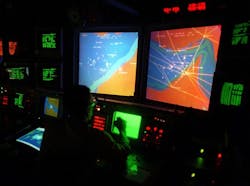Navy looks to ATCA embedded computing architecture for upgrades to Aegis shipboard weapon system
To do this Navy officials are looking to Artesyn Embedded Technologies in Tempe, Ariz., to enhance, upgrade, and insert new technologies into Aegis, and are considering ATCA for future embedded computing upgrades to the Ship Self Defense System, says Rob Persons, field applications engineer at Artesyn.
Using ATCA for Aegis is part of an Artesyn project to adapt the Network Equipment-Building System (NEBS) design guidelines for the shipboard electronics in Navy surface warships. Persons made his comments this morning at the VITA Embedded Tech Trends conference in Houston.
The Aegis combat system uses powerful computers and radar to track and guide weapons to destroy enemy targets. More than 100 Aegis-equipped ships have been deployed in five navies worldwide. Aegis, not an acronym, refers to the shield of the mythical Greek God Zeus.
Related: Lockheed Martin to upgrade Aegis computer equipment on Navy cruisers and destroyers
Aegis was developed by the Missile and Surface Radar Division of RCA, which after a series of acquisitions became part of the Lockheed Martin Corp. Mission Systems and Training segment in Moorestown, N.J. in 1995.
Artesyn's Aegis-related work involving ATCA and NEBS is through the Navy and is not specifically tied to Lockheed Martin, Persons says. Managing the Navy's Aegis systems are officials of Naval Sea Systems Command in Washington.
The shipboard electronics environment is particularly demanding for its shock and vibration. Ship electronics must be able to withstand the effects of vibration from engines and other onboard systems, and must be able to withstand the intense shock of missile and torpedo hits.
Navy officials refresh Aegis electronics on a schedule of about every four years. Previously designers had relied on the non-standard BladeCenter architecture for Aegis designs, but wanted to move toward the kind of open-systems architecture with ATCA that they previously used years ago with VME, Persons explains. Aegis has been deployed by the Navy since the 1980s.
To adapt ATCA and NEBS building blocks to the Aegis Combat System, Artesyn engineers first stiffened an ATCA chassis sides and back, after having adapted the chassis top and bottom to the Aegis shock-isolated rack, Persons says.
Company experts also were able to screw boards into the chassis to resist the effects of shock and vibration. Navy officials say they would like to use this architecture aboard surface warships for eight years or more before considering new technology insertion approaches.
The Artesyn ATCA architecture for Aegis is particularly useful for adapting third-party embedded computing products, which can be modified easily for this architecture, Persons says.
For more information contact Artesyn Embedded Technologies online at www.artesyn.com, or the Embedded Tech Trends conference at www.embeddedtechtrends.com.
